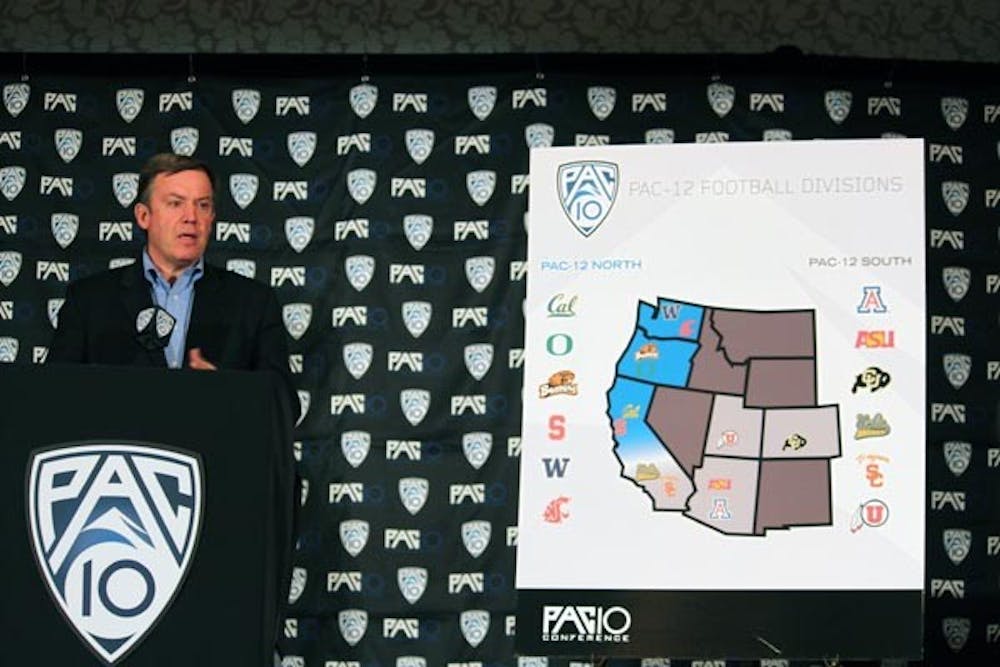Ever since the announcement of the addition of Colorado and Utah to the Pac-10 Conference, a lot of questions have been raised about the future of the conference.
On Thursday, Pac-10 commissioner Larry Scott provided answers and announced plans for football divisions, a football championship game, revenue sharing and future plans for the new Pac-12 conference.
The structure of the divisions is based on geographical location, splitting the conference into a north and south division. The divisions will be used strictly for football.
ASU will be in the Pac-12 South, along with UA, Colorado, UCLA, USC and Utah. The Pac-12 North will feature Oregon, Oregon State, Washington, Washington State, California and Stanford.
Starting in 2011, each team will play five games within its respective division and will play four teams from the other division. Scott noted that schools from the Bay Area and the Pacific Northwest will play a Los Angeles school every other year.
“Not only did we achieve a competitive balance in our divisions, but we were also able to preserve our traditional rivalries as cornerstones of our conference,” Scott said. “These great annual battles have produced some of the most memorable moments in sports history. It was imperative that we kept them in tact.”
A lot of the schools in the new Pac-12 North were originally opposed to being split from the Los Angeles schools, especially the Bay Area schools.
Despite reports of schools being opposed to splitting the California schools, the divisional structure was approved unanimously.
“The engagement we have received from all 12 member institutions and their presidents and chancellors has been tremendous,” ASU president and chairman of the Pac-10 CEO group Michael Crow said. “We have an ambitious plan for the future of our conference and all of that input was vital in allowing us to take these transformational steps.”
With the divisions set, the conference will implement a football championship game starting in 2011. The champions of each division will meet in December to determine the conference’s automatic BCS bid.
The championship game will be played at the home stadium of the division champion with the best record. The conference will develop a tiebreaker procedure in case both division champions have the same record.
“We really did a lot of due diligence on this and we believe this is the best model,” Scott said of the championship game being held at the top seed’s site. “We think it makes sense for us. We will constantly evaluate it.”
Scott also announced that the conference will no longer use the appearance-based revenue model, but will switch to an equally shared revenue model.
Under the old model, the Los Angeles schools earned more money than the rest of the conference. Because of this, until the conference earns $170 million in revenue, UCLA and USC will receive a $2 million payout annually.
“By unanimously adopting a plan for equal revenue sharing we have created a conference with a strong foundation for long term success,” Scott said. “It’s an exciting day for the Pac-12 and all of our fans.”
A huge part of gaining revenue will lie in the development of a television network. Scott said that creating a Pac-12 Network is something that they have had serious discussions about and that there is a lot of interest in the idea.
However, the network still is not in the immediate future. Scott said the conference has a lot of negotiating to do when it comes to its television contract.
The conference will be branded as the Pac-12 and expansion is not in the foreseeable future.
“Our overarching objectives were simple and clear,” Scott said. “We aimed to create 12-team conference for the long term. We are building not just a national but a global brand.”
Also mentioned during the announcement was the possibility of the addition of postseason tournaments for sports that do not currently feature them, such as baseball and softball.
The men’s basketball postseason tournament will remain in Los Angeles through 2012, because Fox determines the placement of the tournament due to the Pac-10’s current television deal. After 2012, the location of the tournament will be discussed.
While there will be talk of winners and losers in the new conference alignment, the decision makers feel confident that this is the best plan for the future of the conference.
"This was the best outcome for the conference," Crow said. "Everyone had to give and take to make that work."
Reach the reporter at andrew.gruman@asu.edu





